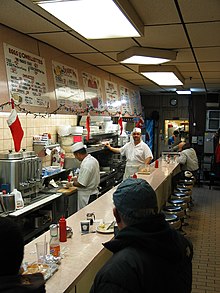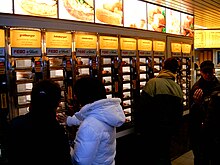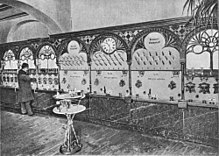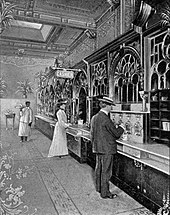Fast food restaurant

A fast-food restaurant is a restaurant that focuses on fast service and fast consumption of the food. Service and prices are lower than other restaurants. The dishes are fast food . Quick service restaurants are often part of franchise chains. Many quick service restaurants are self-service restaurants .
The fast-service restaurants include the American diner and the drive-in restaurants . The dishes are often already prepared and only warmed up.
In contrast to a snack bar , a fast-food restaurant has seats and at least a rudimentary table setting (tray).
history
Fast food restaurants emerged in the United States after World War II . The company White Castle , which initially only sold hamburgers , is considered the first fast-food restaurant chain . The quick service was perfected in the 1950s by McDonald’s through the rational production of products through strict division of tasks in the kitchen.
Self service
Self-service restaurants are quick service restaurants. Organizationally, a distinction is made between self-service on-line , where the guest is led along a bar in a queue, free-flow , where the guest can choose from counters and showcases that are freely set up in the room, and take-away , where the guest is served at a central sales counter with cash register.
cafeteria
A cafeteria is a self-service fast food restaurant where customers queue up with a tray and pass containers and display cases with food from which they make their selections, which they then pay at the checkout. The food and drinks are provided in a line in showcases, in a bain-marie , on a chafing dish , in freezers or in vending machines .
history
This restaurant came form in the US end of the 19th century as a cheap alternative to restaurants with operation , which were for ordinary workers too expensive. The concept of the cafeteria was adopted by canteens , canteens and motorway service stations.
An early cafeteria reserved for men existed in New York as early as 1885. The Young Women's Christian Association opened similar facilities for women in New York and Chicago .
The early cafeterias took the place of company canteens, which many companies did not have at the time. The 1893 World's Fair in Chicago, at which a cafeteria was presented, played an important role in the spread of this fast-food restaurant .
William and Samuel Childs, who in 1898 introduced a self-service buffet and trays for customers in New York, are considered to be the first to operate purely commercially operated cafeterias .
The cafeteria idea first spread to California, followed by the South and Southwest of the USA later with the introduction of self-service in simple restaurants that offered full meals.
Shortly after 1900, the concept of the classic cafeteria, which is still common today, was established at Childs, in which customers queue up with a tray and walk past a row of food offers. The first commercial cafeteria opened in Los Angeles in 1905, advertising that guests could watch the food being prepared and save the tip for the waitress. It was followed by San Francisco and Washington, DC
Surname
The word cafeteria was imported from Mexican Spanish in the USA in the 19th century and has been the name for a specific form of self-service restaurant since the beginning of the 20th century. The Spanish word cafeteria referred to a kind of coffee house in Mexico , in which there were also alcoholic beverages and small dishes. The term was derived from the word cafetero for coffee seller . In the United States, the word cafeteria has been used since 1853, first for California . In 1917 the term was included in US dictionaries. The colloquial abbreviation cafete is also often found in the university environment .
Vending machine restaurant
A vending machine restaurant is a self-service restaurant with seats, in which the dishes and drinks are held in vending machines that are provided with a coin slot so that the customers in the restaurant have no contact with the service staff.
history
The world's first fast-food restaurant of this type was opened by Ludwig Stollwerck in Leipziger Strasse in Berlin in 1896 . It was set up by the Deutsche Automaten Gesellschaft Stollwerck & Co., which Ludwig Stollwerck founded together with the inventors Max Sielaff and Theodor Bergmann in 1895. Ludwig Stollwerck and Max Sielaff had already exhibited a "machine pavilion" in 1886 at the international trade fair. Other cities with "automatic buffets" followed; before the First World War there were around 50 vending machine restaurants in Germany. In 1887 Ludwig Stollwerck and his US business partner John Volkmann founded Volkmann, Stollwerck & Co , which took over the vending machine business in the USA. From 1898, Volkmann, Stollwerck & Co. opened vending machine restaurants in San Francisco, New York, Philadelphia, St. Louis and other American cities.

In the United States, the first automated restaurant opened in Philadelphia in 1902 ; it belonged to the Horn and Hardart Company . Other branches of this operator soon followed, but apart from Philadelphia, they were only successful in New York. In 1950 there were around 85 vending machine restaurants in both cities, in 1979 there were only two. Most of the former Horn and Hardart branches were taken over by Burger King . In the 1950s and 1960s, several fast food chains tried to get into the vending machine business, including White Tower Hamburgers with a system called Tower-O-Matic , but none were successful. Most customers found restaurants that are almost staff-free as too impersonal.
In the Netherlands , vending machine restaurants reappeared as Eten uit de muur at the end of the 20th century , including through the Febo chain .
See also
Web links
Individual evidence
- ↑ a b Fast Food Restaurants . In: Gary Allen et al. a .: The Business of Food , 2007
- ↑ Wolfgang König: Geschichte der Konsumgesellschaft ., Stuttgart 2000, p. 179.
- ↑ Large draft motorway service station. (PDF; 1.1 MB) University of Duisburg-Essen, architecture course
- ↑ a b c cafeterias . In: Gary Allen et al. a .: The Business of Food , 2007.
- ↑ John A. Jakle, Keith A. Sculle: Fast Food. Roadside restaurants in the automobile age . 2002, p. 32.
- ↑ Cafeteria . In: Adrian Room: A Dictionary of True Etymologies , 1988.
- ↑ Cafeteria . In: Allan Metcalf, David K. Barnhart: America in So Many Words: Words That Have Shaped America .
- ↑ On the history of the vending machine restaurant ( Memento of the original from January 23, 2009 in the Internet Archive ) Info: The archive link was inserted automatically and has not yet been checked. Please check the original and archive link according to the instructions and then remove this notice.
- ↑ Bruno Kuske: 100 Years of Stollwerck History 1839–1939 . Cologne 1939.
- ↑ John A. Jakle, Keith A. Sculle: Fast Food. Roadside restaurants in the automobile age . 2002, p. 34 f.
- ↑ From “Eten uit de muur” to “Slow Food”. Center for Dutch Studies at the University of Münster


